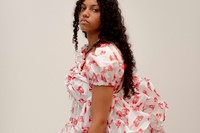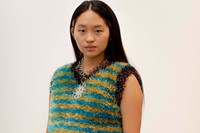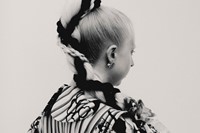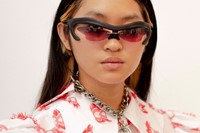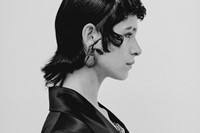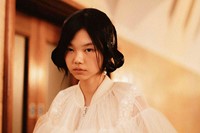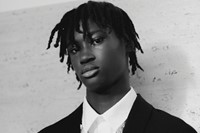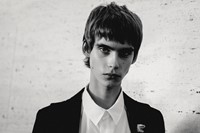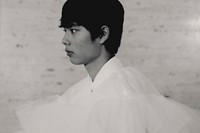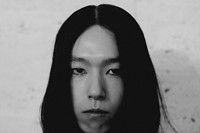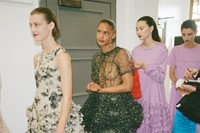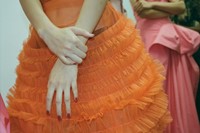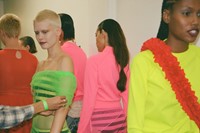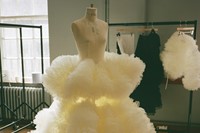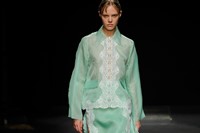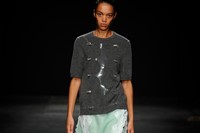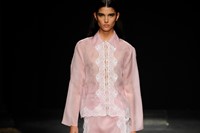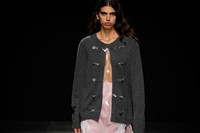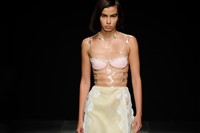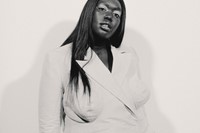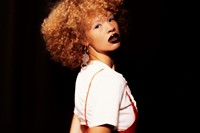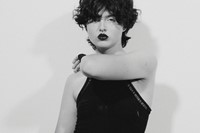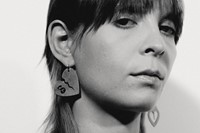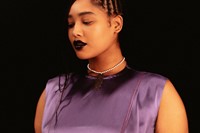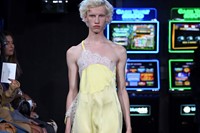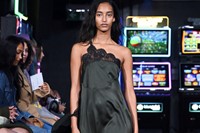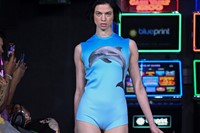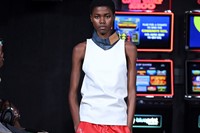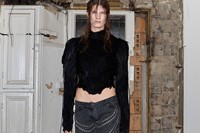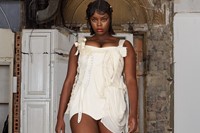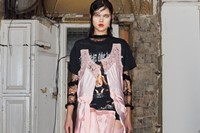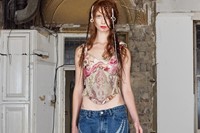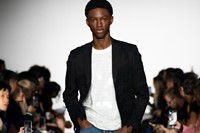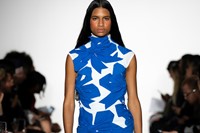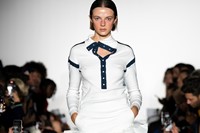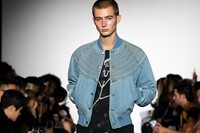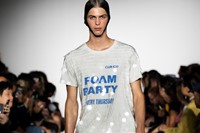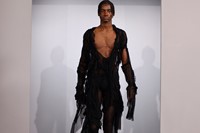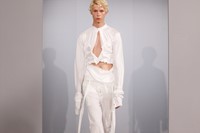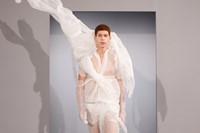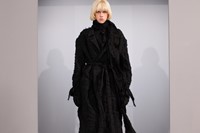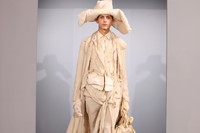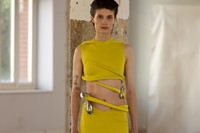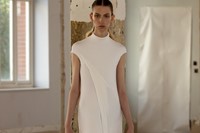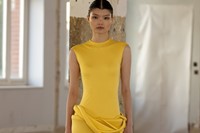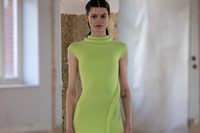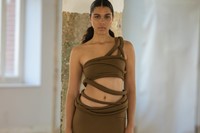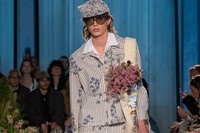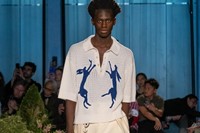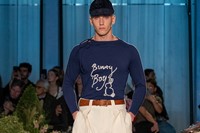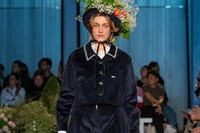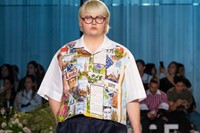From Chopova Lowena’s riotous runway debut to JW Anderson’s surreal comment on technology in a Soho arcade; these are the best collections from London Fashion Week Spring/Summer 2023
Chopova Lowena
Chopova Lowena’s debut runway show was the most talked about of London Fashion Week, with people raving about the raucous vibes and the ingenious street-casting (courtesy of Sarah Small). This season, Emma Chopova and Laura Lowena took uncouth inspiration from lacrosse and the Bulgarian Rose Festival, with models rushing through Porchester Hall to an intoxicating soundtrack of heavy metal, Bulgarian choral music, and amped-up lacrosse players. “We really wanted to wait to have a show to do it in our own venue, and have everything be exactly how we want it,” Chopova told AnOther a few days before the show. “We’ve never been people to rush into things,” says Lowena. “But we’re ready.” Diehard fans of the brand will be pleased to see an abundance of their cult carabiner pleated skirts in the collection (worn by the likes of Harry Styles and Dua Lipa), alongside bristly new tinsel boots and lacrosse-rave hybrid goggles.
Simone Rocha
In the hallowed, marbled halls of the old Bailey, Simone Rocha unveiled her haunting new collection – which, to much fanfare, featured menswear for the first time. Ahead of the show, Rocha spoke with AnOther about her “sensitive approach to masculinity” – true to form, menswear jackets were ruched, frilled or submerged under layers of tulle, while one standout look saw one man ensconced by a flouncy veil, his face sparkling with glitter underneath. “I hope it makes people feel really, really strong,” Rocha says. “There’s almost like … I don’t want to say ‘aggression’, but [it has] a slightly aggressive feel.” This show was one of the Irish designer’s most emotional, with a standing ovation from many teary-eyed spectators – it was difficult not to feel moved by the show’s closing track, This Mortal Coil’s chilling Song To The Siren.
Molly Goddard
Molly Goddard’s S/S23 show, held in the porous, light-filled Seymour Leisure Centre, was an exercise in pure colour. “I was thinking about red carpets pre-internet,” wrote the designer in her press notes. “Dressing felt more for the party and for yourself … people looked like they were out to have fun.” Goddard knows a thing or two about effortless, laidback glamour; her women seem like the life and soul of the party (case in point: Edie Campbell strutting down the S/S18 runway with a fag and a glass of white). This season, Goddard sent women zigzagging across a football pitch in party-ready cowboy boots (sure to be a commercial smash hit), and frilly, sheer dresses in neon highlighter colours; men were kitted out more casually in beloved knitwear, ruched bomber jackets, and suiting with a twist.
Christopher Kane
Christopher Kane is a designer obsessed with the body. In London’s cavernous Roundhouse venue, he put on his first runway show in a year – and boy, did it feel like a proper show. Drawing on physician’s uniforms, the anatomy of the body and flowers (one of the designer’s obsessions), Kane sent out a series of slick, delicate lacy looks with clear vinyl braces strapped around the outside of the body like exoskeletons. “This collection is a celebration of the beauty and complexity of the human body,” he explained, while the show’s booming, medical soundtrack spoke of bones and femurs. This was an intelligent, high-concept collection – one that made you think about what lies beneath the body’s surface – that still managed to retain a strong sense of elegance and wearability.
Sinéad O’Dwyer
Sinéad O’Dwyer’s debut runway show was a remarkable feat of body positivity in an industry that champions thinness above all else. Since launching her eponymous brand in 2018, the Irish designer has catered to bodies of all types and sizes with her hypnotic silicone, satin and silk pieces, and this season was no different; the show featured two models in wheelchairs, one of whom was Emily Barker, a disability activist. “When luxury fashion completely excludes the majority of people, I think it has a really big mental health impact,” O’Dwyer told AnOther in the runup to the show. “Through my own realisation that I really struggled with body dysmorphia and eating disorders myself, I understood that a really powerful aspect of that was access to garments that make you feel like you’re part of luxury fashion.”
JW Anderson
Jonathan Anderson’s London homecoming was a surreal and star-studded affair. Set in the intimate, neon-hued Las Vegas Arcade in Soho (next door to JW Anderson’s flagship store), a cast that included heavy hitters like Hari Nef, Emily Ratajkowski and Ella Emhoff walked the runway in tongue-in-cheek, playful pieces; there were sack-like dresses that mimicked goldfish in plastic bags, a halter neck made entirely out of computer keyboards, a jumper turned upside down on its hanger, and the showstopping, internet-breaking metallic mirror dress, which reflected the audience back at themselves. Backstage, Anderson spoke of falling into our phone screens, while the press notes mentioned a parallel world where people are trapped inside their computers, deigned to explore other dimensions for eternity.
Dilara Findikoglu
Tucked away from the noise in a dilapidated Victorian mansion in Lancaster Gate, Dilara Findikoglu staged a show in silence. It was purposefully unsettling; reminiscent of fashion salons, models walked with a slow saunter just centimetres from the crowd; only an eerie clomp of heel against the hardwood floor told you they were coming. A standout look saw a white overbust corset draped with printed, punk-inspired Union Jacks – atop the model's head was a crown made of hair. Elsewhere, model and daughter to Harry Hamlin and Lisa Rinna, Amelia Gray, stepped out in a corseted, distressed leather dress. It was hauntingly beautiful, bound by a signature hard edge of punk. Findikoglu’s cultural weight has been growing through the years – having been worn by the likes of Bella Hadid and Rihanna and with the introduction of Dilara Swim – this collection, in its details and quality, was her best yet.
Stefan Cooke
For his S/S23 show, Stefan Cooke’s beloved ‘slashed’ knitwear didn’t materialise in the way we expected. Instead, it appeared as texture on denim, slashed on sensible leather derby shoes, and as trompe l’oeil. Translated into new materials, Cooke’s show had a sense of ruined preppiness, a slightly scruffy uptown look. T-shirts came covered in transparent circular payettes which shimmered and swayed. “Playing with the context of clothes is really exciting, changing the form and materials can completely change a piece,” Cooke told AnOther in 2017. This latest collection proved that playtime isn’t over quite yet.
Paolo Carzana
Paolo Carzana’s journey to his S/S23 collection began with a thought jotted on a piece of paper at night: “Imagine we could be the ones to change it all.” In bright whites, dusky greys and blacks – 20 looks that capture the passing of time – the Sarabande scholar took inspiration from the 24-hour period from night to day, in an ethereal presentation supported by Newgen.
Fashion East
Fashion East returned this season with a runway at The Mills Fabrica, a pioneering platform for sustainable innovations in King’s Cross, presenting collections from designer Jawara Alleyne alongside two newcomers to the Fashion East family – Karoline Vitto and Standing Ground. The new arrivals came with decisive, important additions: Brazilian designer Karoline Vitto’s collection was tethered to ideas of the body, having found a new sense of freedom following her move to London, empowered by the folds of skin and rewriting the current narrative around beauty and the feminine form. Standing Ground debuted a collection of monochromatic modern evening dresses and body ornamentation, seeing “the body as a landscape” with sensitive use of draping. Meanwhile, Jawara Alleyne was inspired by the need to dress in extreme heat. The collection felt tropical – itsy-bitsy bikini tops and strappy tops ruled, with a focus on skin, cut and drape.
SS Daley
This season, SS Daley took us on a literary journey of queer love and longing. With performers-cum-models reciting letters from the 1910s and 1920s between Vita Sackville-West and Violet Trefusis – queer women who defied the strict codes of patriarchal English society – Daley drew attention to the state of gender and queerness today. “In their letters, there’s a sketch of Vita and Violet arm-in-arm, walking around the south of France.” says Steven Stokey-Daley, who won this year’s LVMH Prize. “They’re all in black, Vita in a tuxedo, and it’s this moment of connection when the tone of their letters is increasingly sad, when they cannot be with one another. The emotion of that moment fills this whole collection.” Sackville-West and Trefusis regularly referenced bunnies and hares throughout their letters, which cropped up as a motif in various looks through the collection, adding to the classically English whimsy that has become the young designer’s signature.

